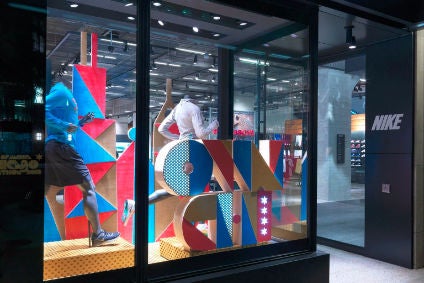
Nike Inc’s focus on driving speed, innovation and digitisation across its business – its so-called Triple Double strategy – has helped the US sporting goods giant to strong growth during the third quarter.
The Beaverton, Oregon-based company saw revenues rise 7% to $9.6bn in the three months to 28 February, up from $8,98bn a year ago and 11% higher on a currency-neutral basis.
Revenues for the Nike Brand were $9.12bn, up 8% on the prior year and 12% on a currency-neutral basis – driven by growth across wholesale and Nike Direct, categories including Sportswear and Jordan, and continued double-digit growth across footwear and apparel.
But while sales in North America, Nike’s largest market, rose 7% to $3.81bn, it nevertheless fell short of estimates, and was down on the 8.5% growth seen in the quarter before.
Nike also saw revenue gains of 6% in Europe, Middle East and Africa; 19% in Greater China – making this its 19th consecutive quarter of double-digit growth; and 3% in Asia Pacific and Latin America.
For Converse, meanwhile, revenues slipped 4% to $463m, down 2% on a currency-neutral basis, with double-digit growth in Asia and digital more than offset by declines in the US and Europe.

US Tariffs are shifting - will you react or anticipate?
Don’t let policy changes catch you off guard. Stay proactive with real-time data and expert analysis.
By GlobalDataGross margin increased 130 basis points to 45.1% thanks to higher average selling prices, favourable changes in foreign currency exchange rates and growth in NIKE Direct, but was partially offset by higher product costs.
The company also swung back to profit in the quarter, posting net income of $1.1bn versus a loss of $921m a year ago.
Company chairman, president and CEO Mark Parker noted business momentum “is being accelerated by our ability to scale innovation at a faster pace and expand new digital consumer experiences around the world.”
Digital’s company-wide gains
Elaborating on a call with analysts, Parker said digital tools were also helping to create company-wide efficiencies within the product-creation teams.
“We fully digitised our palette of over 6,000 footwear materials, allowing our design teams to build on one another’s work and adapt to market trends more quickly,” he explained. Having fewer physical samples also plays an important role in minimising environmental impact.
Overall, advanced digital tools are reducing lead times, leading to faster design cycles, and minimising environmental impact by having fewer physical samples.
The company is also digitally tagging and tracking Nike products all the way from production through retail. “Our RFID [radio frequency identification] initiative, for example, is improving product visibility and is an important step toward integrating our diverse ecosystem of physical and digital experiences, distribution centres and contract factories.
“This will give the consumer easier access to product and allow Nike to more accurately match supply to demand across the world, and ultimately, fuel better, higher-quality growth.
“We’re seeing the early wins pile up in our digital transformation, and it’s bringing scale to every facet of our Triple Double strategy [2X Innovation, 2X Digital, 2X Speed]. What’s so exciting is the more we invest in stronger digital capabilities, the more growth opportunities we uncover. And today, the consumer rewards agility.”
Parker added “The companies who adapt and scale first are the companies who grow fastest. To do that, Nike is looking across the spectrum of the value chain from our factory partners to key cities, so we can take advantage of our most important opportunities.
“At the factory level, that means staging raw materials so they can be quickly deployed to fill requests for our most in-demand products. We did this in anticipation of LeBron’s move to a new team last summer, and it cut our jersey lead times nearly in half.”
This process is a critical component of the firm’s 2X Speed initiative, and is fueling its move to create “a local business, on a global scale” in 12 key cities and 10 key countries around the world, where it can quickly adapt assortments based on the demands of local consumers.
Another important 2X Speed enabler is its Express Lane, which supports key cities with hyper-local product and faster fulfilment to drive higher full price sell-through.
Indeed, in the third quarter the Express Lane in Greater China was responsible for over half of the products in Nike’s Chinese New Year collection.
In North America, the top ten styles in the Nike App all came out of Express Lane; and in EMEA it contributed over 20% of business, Parker said. “Express Lane is just one of the ways we’re driving agility in our value chain to serve consumer demand. We’re also investing in responsive manufacturing and faster delivery capabilities for our key cities.”
Nike also said its stronger supply and demand management was reflected in “healthy inventories” across all geographies, with inventories up just 1% at the end of the quarter.



